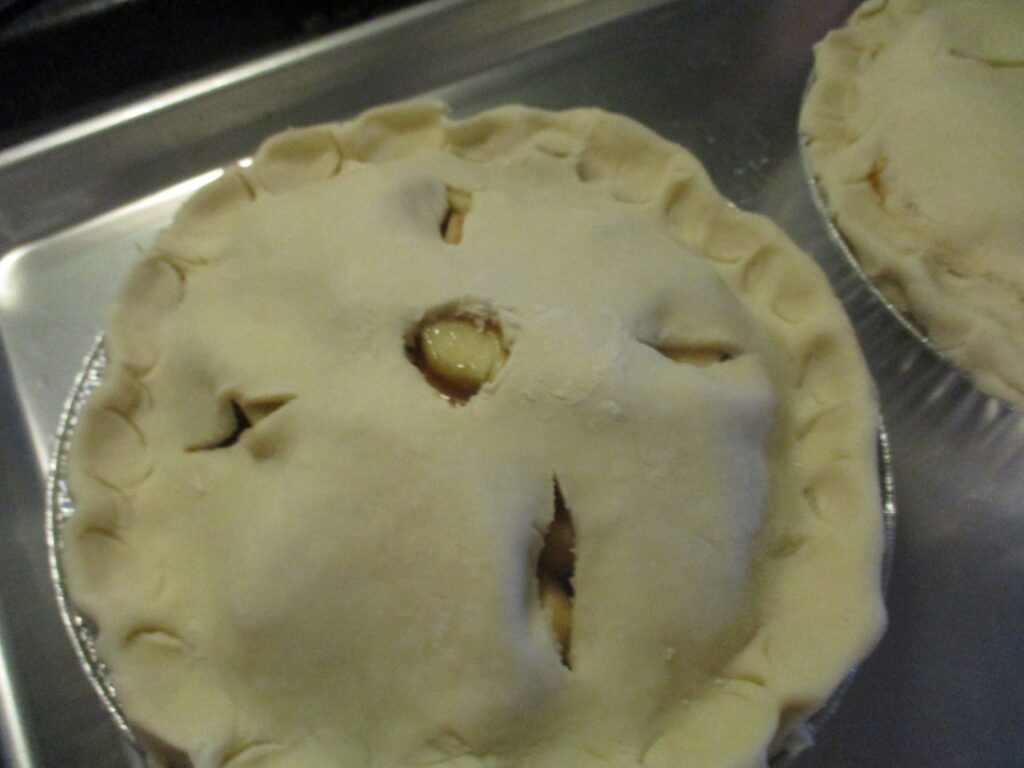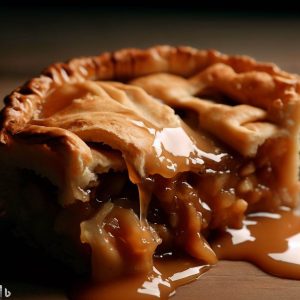Apple pie is my husband’s favorite pie. He requests it every year for his birthday. I mean, who doesn’t love a slice of this American favorite with a generous scoop of vanilla ice cream on top? But don’t believe the saying “as easy as pie.” Because making pie is not really that easy. It takes practice and then some more practice. Not only do you want that tender, flaky crust but a sweet filling that holds up to that flaky crust. The most common question when it comes to that filling is, “Why does my apple pie have so much liquid? In this article, I am going to answer that question. Settle in, get yourself a snack, and read on.
Why Does My Apple Pie Have So Much Liquid?
When it comes to making apple pie, I have found it takes patience and maybe just a little luck. The first pie I ever made was a total disaster. Not only was the crust tough, but when I cut into it, the filling ran everywhere. What a mess! The main culprits to a liquidy apple pie are not venting the top crust. Not using any thickening agents such as flour, underbaking your pie, and cutting that beautiful pie before it has had time to cool down.
Vent The Top Crust

Always remember to vent your top crust. This allows the steam from the juices in the pie to evaporate. Steam is super-heated vapor. This can not only cause structural damage to your pie crust but the excess liquid will turn your top cust soggy and can also cause the filling to get soupy.
All you need to do is carefully cut 2-inch slits around the center of your pie crust. Make sure that you do not cut too deep that you slice into the bottom crust. I usually start with a circle in the center of the pie and then cut the slits around the circle. You can use your finger to widen the slits. 4 to 5 slits are all you need.
Not Using A Thickening Agent


Not using a thickening agent will guarantee that your pie filling will turn into soup. When apples cook, the pectin in the apples breaks down, therefore, making the apples watery. Adding a thickening agent will mix with the liquid of the apples and sugar in your filling to thicken it nicely.
The most common thickening agents are all-purpose flour, cornstarch, and quick-cooking tapioca. All will work well, and the choices are personal. Depending on which one you prefer. I personally prefer cornstarch. Why? I find that flour clumps too easily, and the cornstarch mixes easily into the filling. Quick-cooking tapioca is also an excellent choice but in recent years has gotten too expensive.
A general rule of thumb when using these agents:
All-Purpose Flour- 1 3/4 teaspoon for every 1 cup of Apples
Cornstarch 1/2 teaspoon for every 1 cup of apples
Quick-Cooking Tapioca 3/4 teaspoon for every 1 cup of apples.
Hasn’t Baked Long Enough
You check on your pie, and the crust has turned a beautiful light brown on top, and you think that the pie is done when, in reality, it isn’t. By underbaking, the combination of heat, liquid, and thickener has not had enough time to work its magic. When you see the filling bubbling through the vents, this is a good sign. This shows the filling is actually hot enough to thicken. Bake your pie for 10 minutes more when you see the filling bubbling through the vents.
Also, by underbaking your apple pie, the crust will be flabby and the apples crunchy. You can test the doneness of your apples by inserting a knife into the vents.
Cool Completely Before Cutting
Finally, the pie is done. But wait! Avoid the temptation of cutting into that beautiful pie. If you slice into that pie straight from the oven, not only will your top crust collapse, but it will leave you with a runny/liquidy filling. Why? Because that pie filling is a hot mass of fruit in a starchy sugary syrup. If you slice into it when it is still hot, that syrup will flood everywhere, leaving you with a runny filling. Giving your pie the proper time to cool allows the filling to set properly.
Let your pie cool for at least an hour longer if you can. The longer, the better. If you want a warm slice of apple pie, you can always warm it slightly in the microwave.
Final Thoughts
The saying “as easy as pie” is really deceptive. It takes patience and practice to get that beautiful pie. You want a tender, flaky crust, but you also want a filling that doesn’t run everywhere, leaving you a big, soupy mess. To avoid this catastrophe, remember these 4 things. Vent your top crust. The steam in your baking pie needs to go somewhere. Always use a thickening agent such as flour. The apples cook down and become watery. You need something to thicken that liquid. Do not underbake your pie. You haven’t given the baking pie enough time to work its magic. When you see the filling bubbling out through the vents, bake the pie 10 minutes longer. Do not cut the pie until it is completely cool. This gives the filling time to set up properly.
My pies don’t always look pretty, but my husband says they always taste good. One out of two is not bad in my book.
I hope this little article helped with your dilemma of a liquidy apple pie. Make that apple pie with confidence.
Please leave me a comment below. I would love to hear about your experiences.
Ever wonder what flour is best when making pie crust? You might like this.
And As Always
Keep On Baking
Taianne

I’m Taianne, the owner and operator behind We Are Baking. Baking my first cake at age 11 hooked me on creating sweet treats. Though my interest faded during childhood, it was rekindled when I married my apple pie-loving husband. I love trying new recipes, tweaking classics, and helping others learn the science and art of baking. I started We Are Baking to share tips, tricks, and favorite recipes I’ve discovered over the years. When not in the kitchen, I enjoy spending time with family and friends. My goal is to inspire others to embrace their creativity through baking. Feel free to contact me with any questions!
Taianne@wearebaking.com

